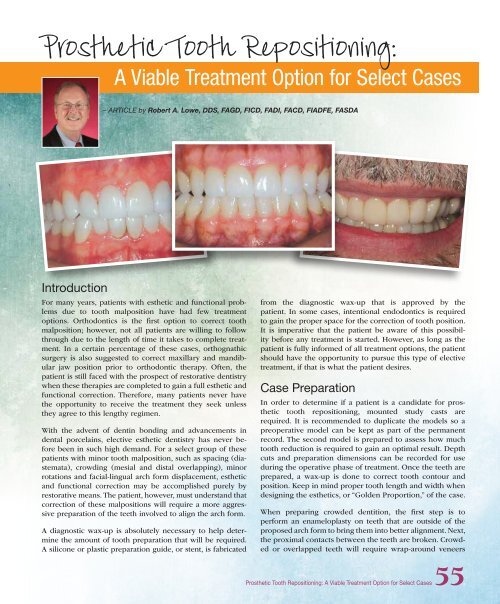PDF Version - Glidewell Dental Labs
PDF Version - Glidewell Dental Labs
PDF Version - Glidewell Dental Labs
You also want an ePaper? Increase the reach of your titles
YUMPU automatically turns print PDFs into web optimized ePapers that Google loves.
Prosthetic Tooth Repositioning:<br />
A Viable Treatment Option for Select Cases<br />
– ARTICLE by Robert A. Lowe, DDS, FAGD, FICD, FADI, FACD, FIADFE, FASDA<br />
Introduction<br />
For many years, patients with esthetic and functional problems<br />
due to tooth malposition have had few treatment<br />
options. Orthodontics is the first option to correct tooth<br />
malposition; however, not all patients are willing to follow<br />
through due to the length of time it takes to complete treatment.<br />
In a certain percentage of these cases, orthognathic<br />
surgery is also suggested to correct maxillary and mandibular<br />
jaw position prior to orthodontic therapy. Often, the<br />
patient is still faced with the prospect of restorative dentistry<br />
when these therapies are completed to gain a full esthetic and<br />
functional correction. Therefore, many patients never have<br />
the opportunity to receive the treatment they seek unless<br />
they agree to this lengthy regimen.<br />
With the advent of dentin bonding and advancements in<br />
dental porcelains, elective esthetic dentistry has never before<br />
been in such high demand. For a select group of these<br />
patients with minor tooth malposition, such as spacing (diastemata),<br />
crowding (mesial and distal overlapping), minor<br />
rotations and facial-lingual arch form displacement, esthetic<br />
and functional correction may be accomplished purely by<br />
restorative means. The patient, however, must understand that<br />
correction of these malpositions will require a more aggressive<br />
preparation of the teeth involved to align the arch form.<br />
A diagnostic wax-up is absolutely necessary to help determine<br />
the amount of tooth preparation that will be required.<br />
A silicone or plastic preparation guide, or stent, is fabricated<br />
from the diagnostic wax-up that is approved by the<br />
patient. In some cases, intentional endodontics is required<br />
to gain the proper space for the correction of tooth position.<br />
It is imperative that the patient be aware of this possibility<br />
before any treatment is started. However, as long as the<br />
patient is fully informed of all treatment options, the patient<br />
should have the opportunity to pursue this type of elective<br />
treatment, if that is what the patient desires.<br />
Case Preparation<br />
In order to determine if a patient is a candidate for prosthetic<br />
tooth repositioning, mounted study casts are<br />
required. It is recommended to duplicate the models so a<br />
preoperative model can be kept as part of the permanent<br />
record. The second model is prepared to assess how much<br />
tooth reduction is required to gain an optimal result. Depth<br />
cuts and preparation dimensions can be recorded for use<br />
during the operative phase of treatment. Once the teeth are<br />
prepared, a wax-up is done to correct tooth contour and<br />
position. Keep in mind proper tooth length and width when<br />
designing the esthetics, or “Golden Proportion,” of the case.<br />
When preparing crowded dentition, the first step is to<br />
perform an enameloplasty on teeth that are outside of the<br />
proposed arch form to bring them into better alignment. Next,<br />
the proximal contacts between the teeth are broken. Crowded<br />
or overlapped teeth will require wrap-around veneers<br />
Prosthetic Tooth Repositioning: A Viable Treatment Option for Select Cases55
















